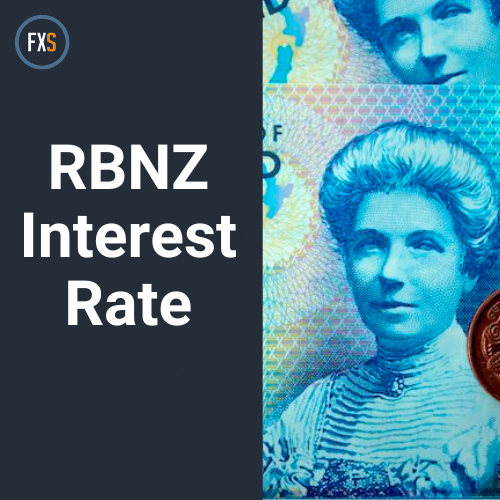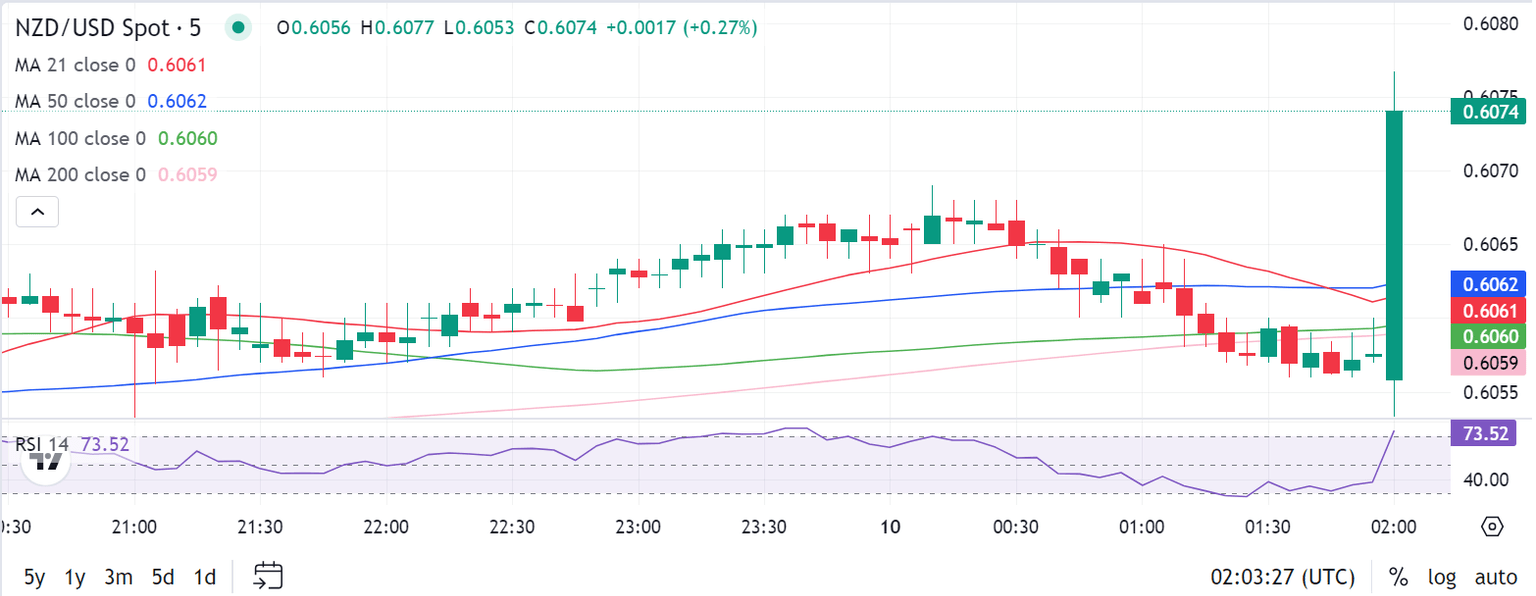RBNZ holds interest rate at 5.50%, as expected

Following the conclusion of the April policy meeting on Wednesday, the Reserve Bank of New Zealand (RBNZ) board members decided to maintain the Official Cash Rate (OCR) at 5.50%.
The decision was in line with the market expectations.
Summary of the RBNZ Monetary Policy Statement (MPS)
The New Zealand economy continues to evolve as anticipatedby the monetary policy committee.
A restrictive monetary policy stance remains necessary to further reduce capacity pressures and inflation.
Economic growth in New Zealand remains weak.
Committee is confident that maintaining the OCR at a restrictive level for a sustained period will return consumer price inflation to within the 1 to 3 percent target range this calendar year.
Minutes of the RBNZ interest rate meeting
Members agreed they remain confident that monetary policy is restricting demand.
Restrictive monetary policy is contributing to an easing in capacity pressures to ensure inflation returns to target.
Further decline in capacity pressure is expected, supporting an ongoing decline in inflation.
Members agreed they remain confident that monetary policy is restricting demand.
Measures of business confidence have declined and firms’ own expectations for activity and investment have weakened.
Near-term business pricing intentions have declined but remain elevated, in part reflecting an uptick in both realised and expected costs.
Continued strength in net migration, is supporting aggregate consumer spending and rising dwelling costs.
The committee agreed that interest rates need to remain at a restrictive level for a sustained period.
Members agreed that the balance of risks was little changed since the February.
Members agreed that there remains limited tolerance to increase the time to achieve the inflation target while inflation remains outside the target band and while inflation expectations and pricing intentions remain elevated.
Members agreed that persistence of services inflation remains a risk and goods price inflation remains elevated.
Ongoing restrictive monetary policy in an environment of weak global growth could lead to a more rapid decline in inflation than expected.
NZD/USD reaction to the RBNZ interest rate decision
The New Zealand Dollar catches a fresh bid in an immediate reaction to the RBNZ ’s status quo. The NZD/USD pair currently trades around 0.6067, up 0.15% on the day.
NZD/USD: 5-minutes chart
New Zealand Dollar price today
The table below shows the percentage change of New Zealand Dollar (NZD) against listed major currencies today. New Zealand Dollar was the strongest against the .
| USD | EUR | GBP | CAD | AUD | JPY | NZD | CHF | |
| USD | 0.04% | 0.00% | -0.09% | 0.05% | -0.04% | -0.05% | 0.07% | |
| EUR | -0.04% | -0.04% | -0.11% | 0.02% | -0.06% | -0.09% | 0.04% | |
| GBP | 0.00% | 0.03% | -0.08% | 0.05% | -0.03% | -0.05% | 0.08% | |
| CAD | 0.08% | 0.11% | 0.09% | 0.12% | 0.04% | 0.02% | 0.15% | |
| AUD | -0.06% | -0.02% | -0.03% | -0.11% | -0.08% | -0.10% | 0.03% | |
| JPY | 0.03% | 0.07% | 0.04% | -0.05% | 0.08% | -0.01% | 0.10% | |
| NZD | -0.06% | -0.02% | -0.06% | -0.13% | -0.01% | -0.09% | 0.01% | |
| CHF | -0.08% | -0.03% | -0.07% | -0.14% | -0.02% | -0.10% | -0.12% |
The heat map shows percentage changes of major currencies against each other. The base currency is picked from the left column, while the quote currency is picked from the top row. For example, if you pick the Euro from the left column and move along the horizontal line to the Japanese Yen, the percentage change displayed in the box will represent EUR (base)/JPY (quote).
This section below was published on Tuesday at 21:15 GMT as a preview of the Reserve Bank of New Zealand (RBNZ) interest rate decision.
- The Reserve Bank of New Zealand is set to hold the interest rate at 5.50% on Wednesday.
- The language in the policy statement will offer cues on the RBNZ interest rate outlook.
- The New Zealand Dollar braces for a big reaction to the RBNZ policy announcements.
The Reserve Bank of New Zealand (RBNZ) is widely expected to maintain the Official Cash Rate (OCR) at 5.50% for the sixth consecutive meeting in a row following the conclusion of its monetary policy meeting on Wednesday.
The New Zealand Dollar (NZD) is primed for a big market reaction to the RBNZ policy announcements despite the absence of RBNZ Governor Adrian Orr’s press conference and the publication of updated economic projections.
What to expect from the RBNZ interest rate decision?
As a rates on-hold decision is fully priced in, markets will closely scrutinize the language and the tone in the Reserve Bank of New Zealand’s Monetary Policy Statement (MPS).
After extending the pause in February, the RBNZ policy statement stated, “conditional on our central economic outlook, we expect the OCR will need to remain around current levels for an extended period for the Monetary Policy Committee to meet its inflation target.”
Speaking at the post-policy meeting press conference, Reserve Bank of New Zealand’s (RBNZ) Governor Adrian Orr noted that “we did discuss a hike in rates”, adding that there was a “strong consensus that rates were sufficient.”
Orr said that he is “still concerned about underlying inflation, how grown inflation is easing.”
Since the February meeting, little data of note has been released from New Zealand to help gauge the timing of the RBNZ’s likely policy pivot. However, with New Zealand’s economy facing its second recession in 18 months and consumer confidence dipping sharply, markets may not be surprised by a dovish hold.
New Zealand’s Gross Domestic Product (GDP) growth contracted 0.1% in the fourth quarter of 2023, following a 0.3% contraction in the third quarter. Meanwhile, ANZ-Roy Morgan New Zealand Consumer Confidence fell by 8.1 points in March to 86.4.
Markets are currently pricing in the first RBNZ’s rate cut in August, with a 75 bps of total easing this year, per BBH Analysts.
On the other hand, the RBNZ could stick to its language from the February MPS, awaiting the first-quarter Consumer Price Index (CPI) report and the labor market data before contemplating any change in its policy outlook.
Data published by Stats NZ showed that New Zealand’s annual Consumer Price Index (CPI) increased by 4.7% for the December quarter, the smallest annual rise in more than two years. However, the figure still remains much above the RBNZ target of 1.0%-3.0%.
Previewing the RBNZ policy announcement, analysts at TD Securities noted: “The RBNZ is expected to keep the OCR on hold at 5.50%. Limited data flow since the February MPS suggests the Bank delivers a similarly worded Statement again.”
“GDP released a week after the February MPS missed the Bank's forecast by a whisker but higher oil prices, weaker NZD, monthly survey releases with price and employment data suggest the inflation outlook still looks challenging,” the analysts added.
How will the RBNZ interest decision impact the New Zealand Dollar?
Risks appear skewed to the downside for the NZD/USD pair heading into the RBNZ showdown on Wednesday, as the US Dollar keeps the upper hand across the board following robust Nonfarm Payrolls data that prompted investors to dial down expectations for a June US Federal Reserve (Fed) rate cut.
Furthermore, expectations of an RBNZ status quo also leave the Kiwi Dollar in the back seat, with a fresh sell-off likely on the cards should the RBNZ policy statement hint toward an earlier-than-expected rate cut.
Conversely, if the MPS suggests that the RBNZ could stick to its “higher for longer” interest rate view amid elevated inflation level, the NZD/USD pair could regain the recovery momentum from five-month lows of 0.5939.
Dhwani Mehta, FXStreet’s Senior Analyst, offers a brief technical outlook for trading the New Zealand Dollar on the RBNZ policy announcements: “The NZD/USD pair is challenging the critical 21-day Simple Moving Average (SMA) at 0.6036 on its road to recovery. The 14-day Relative Strength Index (RSI) indicator, however, is still holding below the 50 level, suggesting that sellers are likely to hold the reins.”
“The immediate upside hurdle is seen at the horizontal 200-day SMA at 0.6068, above which the 0.6100 round level will come into play. NZD buyers will then target the 100-day SMA at 0.6138. Conversely, a sustained move below the 0.6000 level could open doors for a test of the April 5 low at 0.5985. Further south, the five-month kow of 0.5939 could be a tough nut to crack for NZD/USD sellers,” Dhwani adds.
Economic Indicator
RBNZ Interest Rate Decision
The Reserve Bank of New Zealand (RBNZ) announces its interest rate decision after its seven scheduled annual policy meetings. If the RBNZ is hawkish and sees inflationary pressures rising, it raises the Official Cash Rate (OCR) to bring inflation down. This is positive for the New Zealand Dollar (NZD) since higher interest rates attract more capital inflows. Likewise, if it reaches the view that inflation is too low it lowers the OCR, which tends to weaken NZD.
Read more.Last release: Wed Apr 10, 2024 02:00
Frequency: Irregular
Actual: 5.5%
Consensus: 5.5%
Previous: 5.5%
Source: Reserve Bank of New Zealand
The Reserve Bank of New Zealand (RBNZ) holds monetary policy meetings seven times a year, announcing their decision on interest rates and the economic assessments that influenced their decision. The central bank offers clues on the economic outlook and future policy path, which are of high relevance for the NZD valuation. Positive economic developments and upbeat outlook could lead the RBNZ to tighten the policy by hiking interest rates, which tends to be NZD bullish. The policy announcements are usually followed by Governor Adrian Orr’s press conference.
RBNZ FAQs
The Reserve Bank of New Zealand (RBNZ) is the country’s central bank. Its economic objectives are achieving and maintaining price stability – achieved when inflation, measured by the Consumer Price Index (CPI), falls within the band of between 1% and 3% – and supporting maximum sustainable employment.
The Reserve Bank of New Zealand’s (RBNZ) Monetary Policy Committee (MPC) decides the appropriate level of the Official Cash Rate (OCR) according to its objectives. When inflation is above target, the bank will attempt to tame it by raising its key OCR, making it more expensive for households and businesses to borrow money and thus cooling the economy. Higher interest rates are generally positive for the New Zealand Dollar (NZD) as they lead to higher yields, making the country a more attractive place for investors. On the contrary, lower interest rates tend to weaken NZD.
Employment is important for the Reserve Bank of New Zealand (RBNZ) because a tight labor market can fuel inflation. The RBNZ’s goal of “maximum sustainable employment” is defined as the highest use of labor resources that can be sustained over time without creating an acceleration in inflation. “When employment is at its maximum sustainable level, there will be low and stable inflation. However, if employment is above the maximum sustainable level for too long, it will eventually cause prices to rise more and more quickly, requiring the MPC to raise interest rates to keep inflation under control,” the bank says.
In extreme situations, the Reserve Bank of New Zealand (RBNZ) can enact a monetary policy tool called Quantitative Easing. QE is the process by which the RBNZ prints local currency and uses it to buy assets – usually government or corporate bonds – from banks and other financial institutions with the aim to increase the domestic money supply and spur economic activity. QE usually results in a weaker New Zealand Dollar (NZD). QE is a last resort when simply lowering interest rates is unlikely to achieve the objectives of the central bank. The RBNZ used it during the Covid-19 pandemic.
Author

FXStreet Team
FXStreet


















